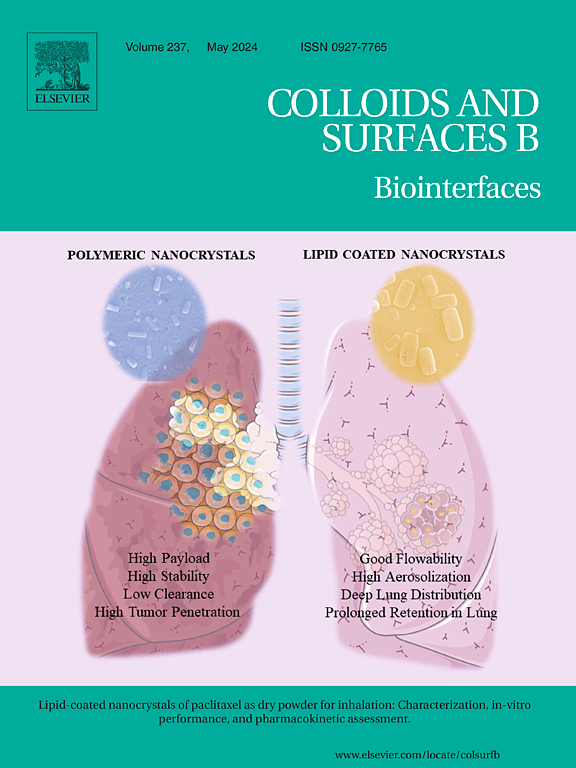MMP2酶反应性细胞外囊泡作为双靶向载体促进巨噬细胞的吞噬作用。
IF 5.4
2区 医学
Q1 BIOPHYSICS
引用次数: 0
摘要
利用抑制肿瘤细胞逃逸和改变肿瘤微环境的联合疗法为癌症治疗提供了一种新策略。这项研究旨在开发一种能调节肿瘤细胞和肿瘤微环境的细胞外囊泡(EV)载体,以实现高效的肿瘤免疫疗法。载体上修饰的配体可靶向免疫检查点 CD47 蛋白,阻止肿瘤细胞逃逸。这种配体会被 MMP2 酶裂解并组装成纳米纤维,从而延长在肿瘤中的滞留时间。这种载体以 CD206 蛋白为靶标,能被 M2 巨噬细胞有效吸收。具有高密度配体(抗 CD206)的载体能与肿瘤细胞产生强烈的受体配体相互作用。由于其刚性较高,这些 EV 在跨膜过程中难以变形,从而降低了阻力,导致 M2 细胞的摄取效率较低。当配体与 EVs 的质量比为 1:25 时,M2 巨噬细胞的摄取效率达到最佳。EVs中负载的克罗恩能促进M2巨噬细胞极化为M1细胞,从而吞噬肿瘤细胞。这项研究揭示了利用细胞外囊泡治疗肿瘤的潜在策略。本文章由计算机程序翻译,如有差异,请以英文原文为准。
MMP2 enzyme-responsive extracellular vesicles as dual-targeted carriers to promote the phagocytosis of macrophages
Combination therapy using inhibition of tumor cell escape and alteration of the tumor microenvironment offers a new strategy for cancer treatment. This study aimed to develop an extracellular vesicle (EV) carrier that regulates tumor cells and the tumor microenvironment to achieve efficient tumor immunotherapy. The ligand modified on carriers targets the immune checkpoint CD47 protein, blocking tumor cell escape. This ligand is cleaved by the MMP2 enzyme and assembles into nanofibers, extending the retention time in the tumor. The carriers target the CD206 protein, enabling efficient uptake by M2 macrophages. Carriers with a high density of ligands (anti-CD206) exhibit strong receptor![]() ligand interactions with tumor cells. Due to their high rigidity, these EVs have difficulty deforming during the transmembrane process, reducing resistance and resulting in low uptake efficiency by M2 cells. The optimal uptake efficiency by M2 macrophages is achieved when the mass ratio of ligand to EVs is 1:25. Crocin loaded in EVs facilitates the polarization of M2 macrophages into M1 cells, which can phagocytize tumor cells. This study reveals a potential strategy for using extracellular vesicles in tumor treatment.
ligand interactions with tumor cells. Due to their high rigidity, these EVs have difficulty deforming during the transmembrane process, reducing resistance and resulting in low uptake efficiency by M2 cells. The optimal uptake efficiency by M2 macrophages is achieved when the mass ratio of ligand to EVs is 1:25. Crocin loaded in EVs facilitates the polarization of M2 macrophages into M1 cells, which can phagocytize tumor cells. This study reveals a potential strategy for using extracellular vesicles in tumor treatment.
求助全文
通过发布文献求助,成功后即可免费获取论文全文。
去求助
来源期刊

Colloids and Surfaces B: Biointerfaces
生物-材料科学:生物材料
CiteScore
11.10
自引率
3.40%
发文量
730
审稿时长
42 days
期刊介绍:
Colloids and Surfaces B: Biointerfaces is an international journal devoted to fundamental and applied research on colloid and interfacial phenomena in relation to systems of biological origin, having particular relevance to the medical, pharmaceutical, biotechnological, food and cosmetic fields.
Submissions that: (1) deal solely with biological phenomena and do not describe the physico-chemical or colloid-chemical background and/or mechanism of the phenomena, and (2) deal solely with colloid/interfacial phenomena and do not have appropriate biological content or relevance, are outside the scope of the journal and will not be considered for publication.
The journal publishes regular research papers, reviews, short communications and invited perspective articles, called BioInterface Perspectives. The BioInterface Perspective provide researchers the opportunity to review their own work, as well as provide insight into the work of others that inspired and influenced the author. Regular articles should have a maximum total length of 6,000 words. In addition, a (combined) maximum of 8 normal-sized figures and/or tables is allowed (so for instance 3 tables and 5 figures). For multiple-panel figures each set of two panels equates to one figure. Short communications should not exceed half of the above. It is required to give on the article cover page a short statistical summary of the article listing the total number of words and tables/figures.
 求助内容:
求助内容: 应助结果提醒方式:
应助结果提醒方式:


